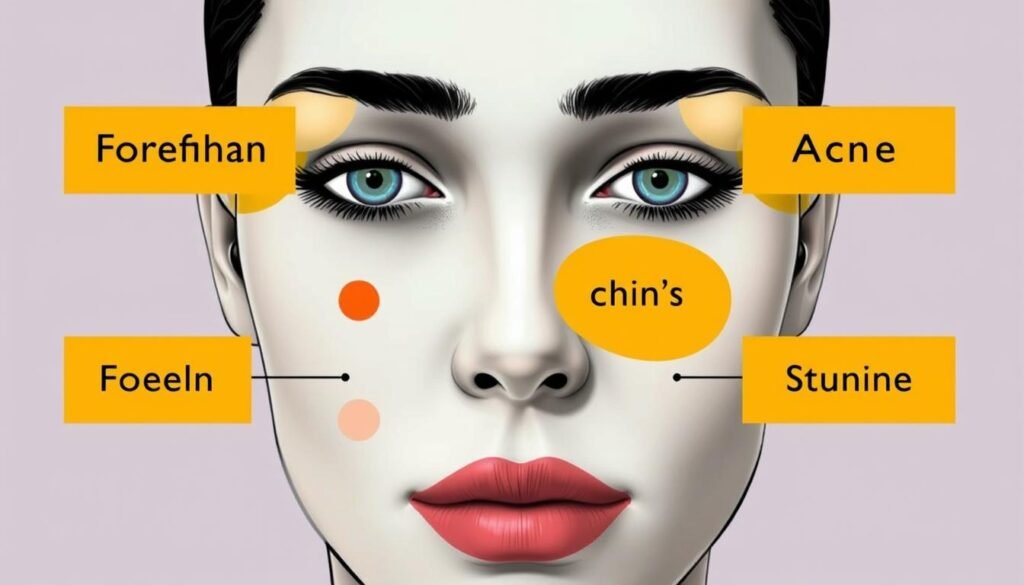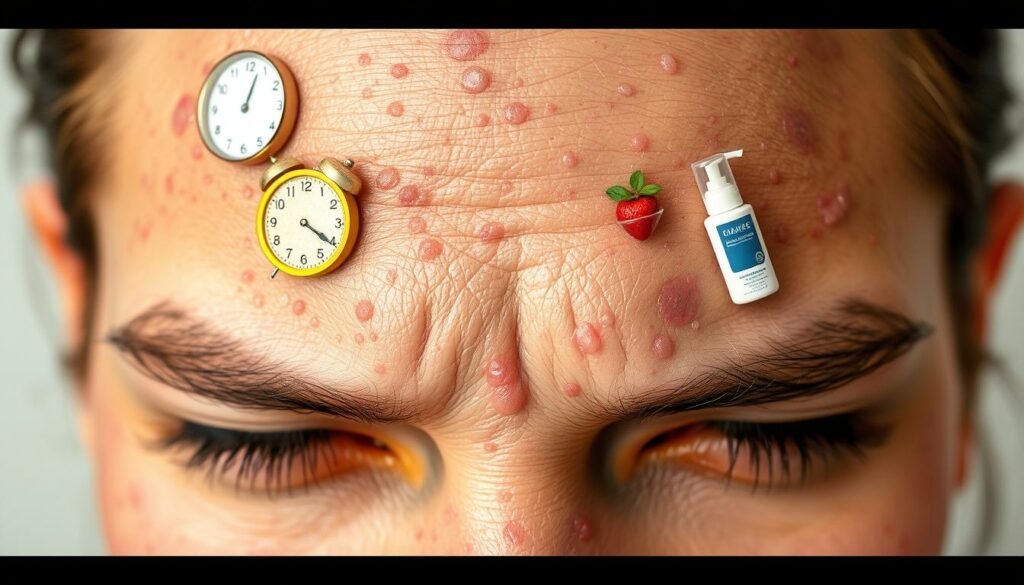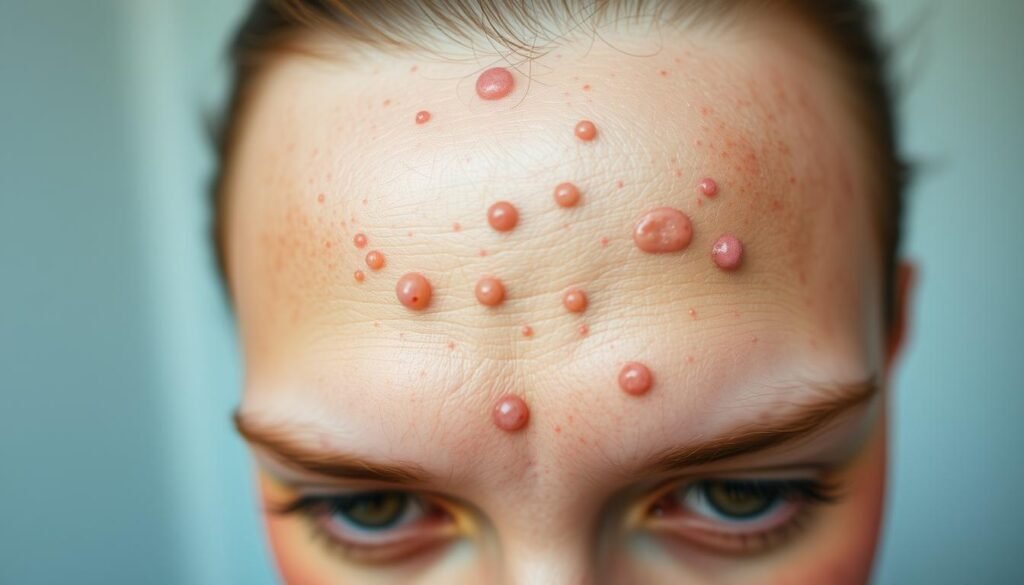Acne is the top skin problem in the U.S., says the American Academy of Dermatology. Millions get it every year. Forehead acne tells us about different health and lifestyle issues. Ancient Chinese medicine linked parts of the face to health. But now, we know it’s more complicated. Things like too much oil, blocked pores, hormone shifts, stress, and hair products play a role.
Knowing what acne on forehead meaning is can help us live better. We can then treat forehead acne more effectively. It’s key to blend old beliefs with new science. This can clear up our skin and improve our health.
Key Takeaways
- Forehead acne might point to different issues in health or life.
- Old face mapping linked face areas to organs. Now we see it’s more involved.
- Main causes are too much oil, blocked pores, and bacteria.
- In women, hormonal shifts can make acne worse. This often happens during their periods.
- Understanding forehead acne causes helps pick the right treatments.
- It’s very important to take care of ourselves daily to stop forehead acne.
Understanding Acne: What Happens Under the Skin
Acne is a common skin issue that many face. It’s when oil and dead skin cells clog hair follicles. This can lead to pimples and blackheads. Oil-producing sebaceous glands play a role in acne. Knowing the causes of acne helps in tackling forehead acne and improving skin health.
Hormones and stress have a big part in acne development. About 85% of women get breakouts before their periods. These hormonal changes can make existing skin problems worse, leading to more acne. It’s crucial to understand what causes these flare-ups. For more information, check out treatment options for acne.
There are many ways to treat acne. Topical retinoids, from vitamin A, prevent and lessen scars. Oral solutions include antibiotics and isotretinoin for tougher cases. Natural options like aloe vera and tea tree oil are beneficial too.
Keeping a good skincare routine is important. Avoid harsh chemicals and opt for gentle, non-comedogenic products. A tailored skincare plan can specifically target forehead acne.
| Treatment Type | Effectiveness | Examples |
|---|---|---|
| Topical Treatments | Moderate | Topical retinoids, benzoyl peroxide |
| Oral Medications | High | Antibiotics, isotretinoin |
| Natural Remedies | Variable | Aloe vera, tea tree oil |
| Laser Treatments | High | AviClear System, PDT |
What Is Face Mapping and Its Connection to Acne
Face mapping is an old technique from Chinese and Ayurvedic medicine. It says different parts of the face link to internal organs. This method reveals health issues through acne locations. Though science hasn’t fully backed it up, some research connects skin breakouts, like forehead pimples, to health problems.
The forehead, prone to pimples, might point to issues with digestion, stress, or general health. Traditional methods say skin flaws can show organ health. For example, forehead acne could signal digestive system problems due to a bad diet or stress.

Dermalogica’s approach to face mapping offers detailed zone connections. Acne near the temples might suggest kidney or bladder issues, while between the eyebrows might mean liver health concerns. Knowing these forehead pimples meanings can help you make healthy lifestyle changes.
| Facial Zone | Related Organ | Potential Issues Indicated |
|---|---|---|
| Forehead | Digestive System | IBS, poor diet, stress |
| Temples | Kidneys/Bladder | Inflammation, infections |
| Between Eyebrows | Liver | Detoxification issues |
| Cheeks | Respiratory System | Allergies, pollution |
| Nose | Heart | Circulatory issues |
Face mapping leads to a whole-body view of skincare. It shows how diet and stress can affect acne locations. This insight helps in handling breakouts and discussing health with doctors.
Forehead Acne Causes
Forehead acne comes from many sources, affecting how the skin looks and feels. Knowing the forehead acne causes is key to fixing and managing outbreaks. Factors like too much oil, bacteria, and even certain hair products are big contributors to this skin problem.
Excess Oil Production and Clogged Pores
Too much oil from sebaceous glands is a leading cause of adult forehead acne. This oil teams up with dead skin to block pores, causing inflamed acne spots. Hormones or genes can make oil production go into overdrive. Dealing with these can help in fighting forehead acne. A good skincare routine can control oil and keep new pimples at bay.
Bacterial Involvement in Forehead Acne
A type of bacteria called Propionibacterium acnes plays a role in causing forehead acne. They can thrive in clogged pores and make inflammation worse. Stress and poor diet can make this bacteria problem bigger. Knowing this helps people find ways to calm inflammation and have healthier skin.
Impact of Hair Products on Forehead Skin
Certain hair products can make forehead acne worse. This is often called “pomade acne.” Oils from these products can end up on the forehead, leading to blocked pores and more acne. For those dealing with acne, looking at haircare choices is important. Changing products and cleaning the skin well can make a huge difference.

Hormonal Factors Contributing to Forehead Acne
Hormones play a big role in causing acne, especially for women. Changes in hormones can lead to acne on the forehead. This is clear during puberty, menstruation, pregnancy, and menopause.
Understanding Hormonal Acne on Forehead
Hormonal acne is linked to changes in the body’s hormones. During puberty, more testosterone means more sebum, leading to blocked pores. This acne is often found on the forehead.
In women, hormone swings can make acne worse during their periods. This is due to more oil and sensitive skin.
The Role of Androgens and Menstrual Cycle
Androgens increase acne problems. Women see this mostly around their periods. Higher androgens mean more oil and acne, mainly on the forehead.
Conditions like PCOS mess with hormone levels and can make acne worse. Managing these changes involves treatments focusing on oil and hormones. Learn more about this here.
Identifying the Acne on Forehead Meaning
Forehead acne can tell us a lot about our skin health. The forehead is part of the T-zone, which has lots of oil glands. When we get breakouts here, it might mean something needs our attention.
What we eat affects our skin. Too much sugar can cause more oil and lead to forehead acne. Looking closely at our diet can help us find and fix these issues.
Being stressed out can also affect our skin. Long-term stress makes more oil in our T-zone. It’s important to find ways to deal with stress to keep our skin clear.
Hormonal changes are another big reason for acne. Things like menstrual cycles, pregnancy, and menopause can cause breakouts on the forehead. This area shows hormonal changes more clearly than others.
Understanding what our forehead acne means can show us what we need to change. This might be our diet, how we handle stress, or knowing about hormonal changes. Noticing these signs can help us have healthier skin.

Stress Acne on Forehead: How Emotions Affect Skin
Stress acne on the forehead is often tied to how we feel inside. Stress causes our bodies to make more hormones. These hormones increase oil production in our glands.
This oil boost worsens acne, especially on the forehead. Pimples heal slower and get more inflamed during these times. Knowing how stress affects skin health is crucial.
Connection Between Stress and Increased Sebum Production
Our emotions play a big role in our skin’s health. Stress leads to more oil on our skin by making more androgens. This oil blocks pores, making acne worse.
While stress doesn’t start acne, it can make it harder to handle. Since 85% of people get acne at some point, managing stress is key.
Strategies for Managing Stress to Reduce Acne
Managing both stress and acne means adopting helpful habits. Here are some key ways to ease stress and maybe help clear up your skin:
- Mindfulness and Meditation: Reducing anxiety and boosting well-being.
- Exercise: Eases stress and betters skin health.
- Deep Breathing: Helps in relaxing and lowering stress.
- Support Systems: Helps beat feelings of being alone and worried.
- Healthy Lifestyle Choices: Important for both mood and skin.
These steps can make acne better over time. Remember, handling stress well, along with acne treatments, is the best plan. For more on how emotions affect acne, check out this resource.
| Stress Management Strategy | Benefits |
|---|---|
| Mindfulness and Meditation | Reduces anxiety, enhances emotional resilience |
| Exercise | Boosts mood, enhances skin health |
| Deep Breathing | Promotes relaxation and lowers cortisol levels |
| Support Systems | Encourages sharing feelings, reducing isolation |
| Healthy Lifestyle Choices | Improves overall well-being and skin condition |
Effective Treatments for Forehead Acne
Treating forehead acne involves a mix of methods. They are tailored to what your skin needs. There are many options, from creams to natural cures. This range helps treat different types of skin and acne.
Topical Treatments: What Works Best
Topical treatments have helped many with forehead acne. Products with benzoyl peroxide or salicylic acid are top picks. They reduce swelling and open blocked pores. Tretinoin, a kind of retinoid, can also prevent new breakouts by speeding up skin renewal.
Oral Medications for Persistent Cases
Severe forehead acne might need oral meds. Dermatologists often prescribe clindamycin antibiotics for fighting bacteria. Hormone treatments, like birth control pills, can tackle acne linked to hormones. For tough cases, an oral retinoid called isotretinoin could be used.
Natural Remedies and Home Treatments
For a softer approach, try natural remedies and home treatments. Tea tree oil, aloe vera, and green tea extract are becoming popular for their skin-helping effects. Adding these to your skincare routine might improve mild acne.
Preventing Forehead Acne: Daily Care Tips
To stop forehead acne, follow simple acne prevention strategies. A steady skin care ritual is key. It lays the groundwork to fight off forehead acne.
Use noncomedogenic products for gentle cleaning. This helps avoid pore blockages. Washing your face two times a day gets rid of oil and dirt. Also, keep your hair away from your forehead to prevent skin irritation from hair products.
- Maintain a balanced diet rich in nutrients to support skin health.
- Stay hydrated to assist in overall well-being and skin hydration.
- Manage stress through relaxation techniques like meditation or exercise.
Adding these routines to your daily life can greatly help in preventing forehead acne. Having a regular skincare routine and making smart lifestyle choices lets you control acne. This way, you can improve how your skin looks and feels.
Conclusion
But what causes acne on the forehead? It’s key to grasp this for better acne control. It kickstarts with recognizing things like hormonal shifts, stress, and what we eat. Knowing this, one can delve into skincare routines more effectively, aiming to reduce breakouts.
Building good skin habits is crucial. This means keeping the face clean, choosing the right hair products, and doing regular skin evaluations. Habits like washing your face often and picking light hair products can make a big difference.
And if the acne persists? It’s smart to look into your options. Turning to expert advice on acne treatments can be a game-changer. Not just for your skin, but for feeling good overall. Using treatments like creams or doctor-prescribed meds can be the path to clearer skin.